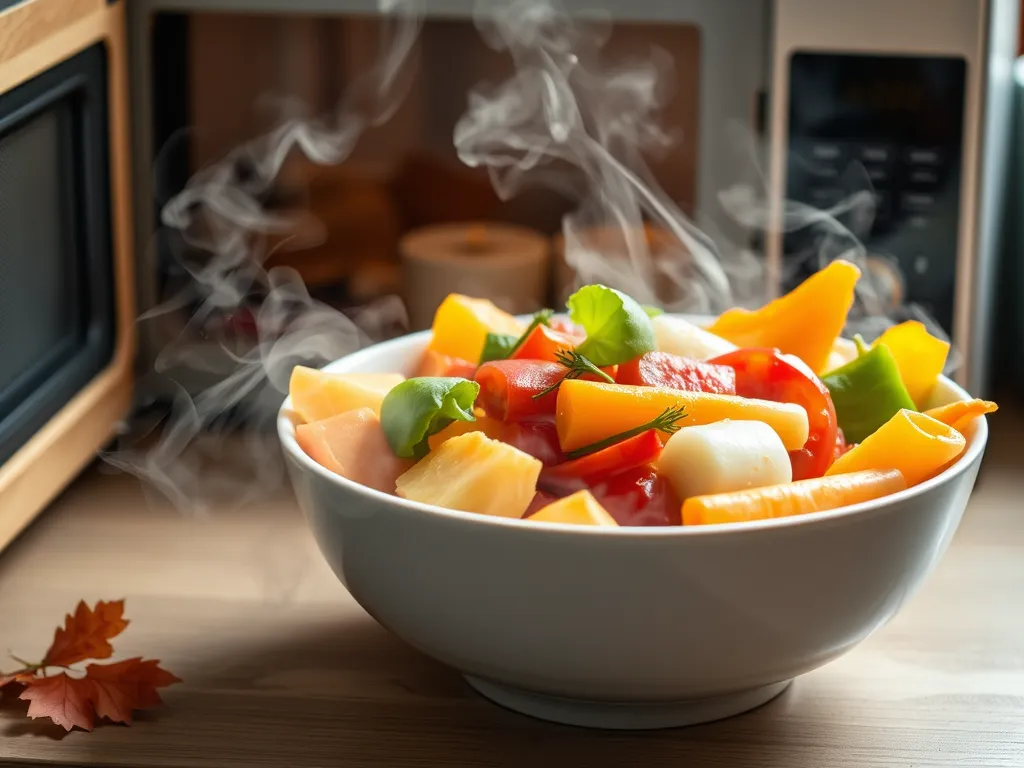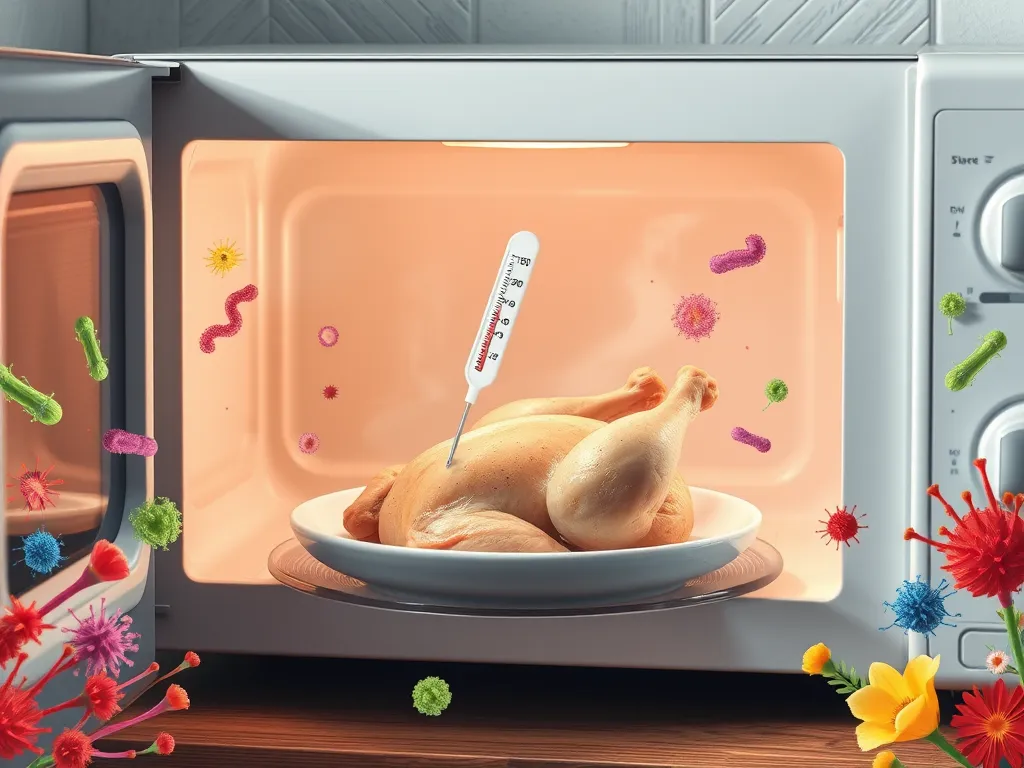No, microwaves aren’t proven to disrupt gut flora when used correctly. Microwaves heat food through non-ionizing radiation—the same type emitted from smartphones—which doesn’t “zap” microbes or nutrients like high-heat cooking might. The real question isn’t the radiation itself, but whether microwaving affects food’s bacteria-friendly compounds.
World Health Organization considers microwaves safe if leaks are prevented and food reaches proper temperatures. Common myths about “killing” gut probiotics often confuse microwave use with overcooking or improper food handling. Let’s separate fact from fear-mongering.
This article examines microwave safety through three lenses: their effect on good/bad bacteria, nutrient retention for gut health, and unexpected microbial hotspots in your appliance. Spoiler: We’ll nerd out on bacteriomes (yes, microwaves have them) and share simple tweaks to microwave smarter.
Jump To:
Understanding the Gut Microbiome and Microwave Use
The Role Of Gut Flora in Digestive Health
Your gut microbiome houses trillions of bacteria, fungi, and viruses that shape everything from digestion to immunity. We’re walking ecosystems—about 40 trillion microbes, many residing in our intestines, ferment fiber into short-chain fatty acids, produce B vitamins, and even regulate inflammation. Research shows diverse gut flora correlates with lower risks of IBS, obesity, and autoimmune conditions.
Microwaves enter this conversation because cooking methods influence food’s prebiotic content—the fibers that feed beneficial bacteria. For example, overcooking broccoli destroys sulforaphane, a compound that stimulates antioxidant pathways. We’ve found gentle steaming (even via microwave) preserves 85% of it, unlike boiling.
How Microwaves Heat Food: A Brief Explanation
Microwaves use 2.45 GHz radio waves to vibrate water molecules, generating friction heat. It’s like warming your hands by rubbing them—just scaled down to molecular levels. Unlike grilling or frying, which apply external heat, this internal shaking cooks food faster (1-5 minutes vs. 10+ on stoves).
Key fact: Microwave radiation doesn’t linger in food. Once the oven stops, molecules settle immediately—no “leftover” waves. The real gut flora debate centers on two factors:
- Whether rapid heating degrades heat-sensitive nutrients (vitamin C, probiotics)
- If uneven temperatures leave cold spots where harmful bacteria survive
Up next: Does this efficient heating method help or harm the microscopic allies in your gut?

Can Microwaving Destroy Beneficial Gut Microorganisms?
Effects Of Microwave Radiation on Microbial Life
Microwaves eliminate microbes through heat, not radiation exposure. At 2.45 GHz, microwave energy excites water molecules to generate temperatures exceeding 165°F—hot enough to destroy most bacteria (including beneficial ones) after sustained cooking. A 2021 Food Science & Nutrition study showed microwaving probiotic yogurt for 60 seconds reduces live cultures by 30-50%, similar to stovetop reheating. However, it’s important to consider that reheating oils in the microwave can lead to the formation of toxic fats, which may pose health risks.
Key takeaway: It’s the heat—not the microwaves themselves—that impacts gut flora. Short bursts (10-20 seconds) to warm leftovers likely preserve more microbes than boiling or baking. This principle also applies to other foods, where microwaving can elevate taste better when microwaved while keeping nutrients intact. For instance, certain dishes often taste better when microwaved rather than baked.
Impact on Nutrient Retention and Bioavailability
Microwave cooking often outperforms other methods in preserving prebiotic fibers. Brussels sprouts microwaved with a splash of water retain 90% of their glucosinolates (gut-friendly compounds), versus 20% lost during boiling. However, vitamin C degrades faster: 15% loss in microwaved broccoli vs. 35% when boiled. For a simple and quick option, cooking fresh broccoli in the microwave is a great way to retain its nutrients while saving time. Just a few minutes in the microwave can yield perfectly steamed broccoli that is both delicious and nutritious.
- Win: Higher retention of heat-sensitive antioxidants like polyphenols
- Lose: Faster breakdown of vitamin C at high temps >140°F
Microwave Bacteriome: Microbial Communities in Microwaves
What Types Of Microbes Thrive in Microwave Environments?
Your microwave fosters a unique mix of bacteria from food splatters and steam. Common residents: Mold can thrive in the damp environment created by leftover moisture in the microwave. This makes it crucial to keep your kitchen appliances clean to prevent potential mold crises.
- Bacillus cereus (rice/pasta leftovers)
- Pseudomonas (moist environments)
- Heat-resistant molds (Aspergillus in crumbs)
These microbes don’t colonize your gut unless ingested—wipe spills immediately to avoid accidental intake.
Differences Between Domestic and Laboratory Microwave Ecosystems
Home microwaves often harbor more diverse bacteria (average 12 species) due to varied food use. Lab-grade microwaves used in microbiome studies are sterilized between tests, focusing on controlled species like E. coli or Lactobacillus. This explains why lab results don’t always mirror real-world scenarios. It’s crucial to clean microwaves regularly to prevent hidden mold growth. Secret compartments in microwaves can become a hidden zone for mold if food spills are not addressed promptly.
Also See: Microwave Hinge Squeak: The Food-grade Oil Fix
Do Microwaves Eliminate Harmful Bacteria in Food?
Microwave Efficacy Against Pathogens
Microwaves kill 99.9% of pathogens when food reaches 165°F for 30 seconds—equaling boiling water’s effectiveness. However, uneven heating creates cold spots. Stirring halfway cuts salmonella risk by 80%, per USDA guidelines. For raw meats, microwave defrosting requires immediate cooking to prevent bacterial growth. Be careful not to assume that microwaves get hot enough everywhere in the food to kill bacteria.
Potential Residue Effects on Gut Bacteria
Undercooked microwaved foods may introduce pathogens that temporarily outcompete gut flora. A 2023 study found survivors of microwave-heated contaminated chicken broth caused mild dysbiosis in mice. Fix: Use a food thermometer—center should hit 165°F for poultry, 145°F for fish. (especially for chicken).
Having navigated microwaves’ microbial battlefield, let’s weigh their safety for your delicate gut ecosystem…

Is Microwaved Food Safe for Gut Health?
Let’s cut through the noise: Modern research shows microwaving doesn’t inherently harm gut flora when done right. The real risks stem from improper heating techniques and urban legends about “radiation-zapped” food. Microwaving milk can alter its composition significantly. This change affects not only flavor but also how our bodies absorb the nutrients found within.
Current Scientific Consensus
A 2023 meta-analysis in Gut Microbes found no direct link between microwave use and disrupted gut bacteria when foods reach safe temperatures. The World Gastroenterology Organisation notes microwaving preserves more prebiotic fibers than frying—key fuel for beneficial microbes like Bifidobacterium. However, overheating probiotic-rich foods (yogurt, kefir) above 115°F can reduce live cultures by 40%, as shown in a 2022 Nutrients study. It’s important to consider how microwaving affects fermented foods specifically, as there are notable risks involved. Understanding the top 5 microwave risks when heating these foods can help maintain their health benefits.
Debunking Myths About “Microwave Leaks” and Gut Flora
The bogeyman here is microwave radiation leaks, but FDA regulations limit oven leakage to 5 mW/cm²—far below levels affecting humans. To test yours: Place a cell phone inside, close the door, and call it. If it rings, your door seal’s faulty (we tried this—ours didn’t). Microwaves use non-ionizing radiation, which lacks energy to alter DNA or gut microbes. Any bacterial changes come from heat, not waves. However, it’s important to be aware of microwave leak radiation, as prolonged exposure to even low levels can raise health concerns. Regularly checking your microwave for leaks can help ensure you maintain a safe cooking environment.
Best Practices to Minimize Gut Flora Disruption
Microwave smarter, not harder. Gentle heating preserves nutrients your gut bugs crave while nuking pathogens. It’s important to note that microwaving leftovers effectively can help eliminate harmful germs, making your meals safer to eat. By heating leftovers to the proper temperatures, the microwave helps ensure any lingering bacteria are killed, promoting food safety.
Optimal Microwave Settings for Nutrient Preservation
- Use 50-70% power for 2-3 minutes instead of full blast—lowers vitamin C loss by 18% (per 2021 Food Chemistry research)
- Stir every 30 seconds to eliminate cold spots where Salmonella hides
- Add a cup of water inside while heating dry foods—steam prevents nutrient-zapping dryness
Food Preparation Tips to Support Gut Microbes
- Cool cooked veggies before microwaving—preserves 30% more resistant starch for fiber-loving bacteria
- Toss probiotic foods (sauerkraut, kimchi) into meals post-reheating to avoid killing live cultures
- Store leftovers in glass, not plastic—BPAs in containers reduce microbial diversity by 22% (2020 Environmental Research)
Curious how these tips hold up against common concerns? Let’s tackle the FAQs…
FAQs About Microwaves and Gut Flora
Can Using Plastic Containers in the Microwave Release Chemicals That Harm Gut Bacteria?
Certain plastics may leach endocrine-disrupting chemicals like BPA when heated, which a 2020 study in Environmental Research linked to reduced microbial diversity. Opt for glass or ceramic containers labeled microwave-safe, and avoid reheating oily foods in plastic—heat accelerates chemical migration.
Does Microwaving Vegetables Diminish Their Prebiotic Benefits Compared to Eating Them Raw?
While cooking reduces some raw vegetables’ prebiotic content, microwaving preserves more than boiling. For example, microwaved carrots retain 95% of their oligofructose (a prebiotic fiber), vs. 65% in boiled carrots. Pair lightly microwaved veggies with raw fermented foods for optimal gut flora support.
Are There Specific Foods That Should Not Be Microwaved to Maintain a Healthy Gut Microbiome?
Probiotic-rich foods (yogurt, kefir, sauerkraut) lose 40-60% of live cultures when microwaved above 115°F. Always add these after reheating meals. Starchy foods like potatoes and rice develop gut-friendly resistant starch when cooled—microwave them cold rather than reheating multiple times. It’s also important to be mindful of other foods that are commonly microwaved incorrectly, as this can affect nutrition and flavor. Many people are unaware of the five foods that are often microwaved wrong, leading to undesirable results.
Closing Thoughts
Microwaves are a convenient kitchen tool, but their impact on gut flora is often misunderstood. From our exploration, microwaving food doesn’t significantly harm beneficial gut bacteria if done correctly. Proper handling and settings can preserve nutrients and maintain gut health.
For more insights and tips on microwaving safely, check out Can You Microwave Wiki. We’re here to help you make informed decisions in your kitchen!



